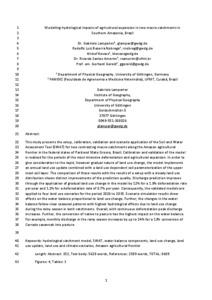Modelling hydrological impacts of agricultural expansion in two macro-catchments in Southern Amazonia, BrazilLamparter, G., Nobrega, R., Kovacs, K., Amorim, R. S. and Gerold, G. (2018) Modelling hydrological impacts of agricultural expansion in two macro-catchments in Southern Amazonia, Brazil. Regional Environmental Change, 18 (1). pp. 91-103. ISSN 1436-3798
It is advisable to refer to the publisher's version if you intend to cite from this work. See Guidance on citing. To link to this item DOI: 10.1007/s10113-016-1015-2 Abstract/SummaryThis study presents the setup, calibration, validation and scenario application of the soil and water assessment tool for two contrasting macro-catchments along the Amazon agricultural frontier in the federal states of Pará and Mato Grosso, Brazil. Calibration and validation of the model are realised for the periods of the most intensive deforestation and agricultural expansion. In order to give consideration to the rapid, however gradual nature of land use change, the model implements an annual land use update combined with a land use dependent soil parameterization of the upper most soil layer. The comparison of these results with the results of a setup with a steady land use distribution shows distinct improvements of the prediction quality. Discharge prediction improves through the application of gradual land use change in the model by 12 % for a 1.8 % deforestation rate per year and 1.2 % for a deforestation rate of 0.7 % per year. Consequently, the validated models are applied to four land use scenarios for the period 2026–2035. Scenario simulation results show effects on the water balance proportional to land use change. Further, the changes in the water balance follow clear seasonal patterns with highest hydrological effects due to land use change during the rainy season in both catchments. Overall, with continuous deforestation, peak discharge increases. Further, the conversion of native vegetation to pasture has the highest impact on the water balance. For example, monthly discharge in the rainy season increases by up to 24 % for a 13 % conversion of Cerrado savannah into pasture.
Download Statistics DownloadsDownloads per month over past year Altmetric Deposit Details University Staff: Request a correction | Centaur Editors: Update this record |
 Lists
Lists Lists
Lists![[img]](/75081/1.hassmallThumbnailVersion/Lamparter_Hydrology_SouthernAmazonia_accepted.pdf)
